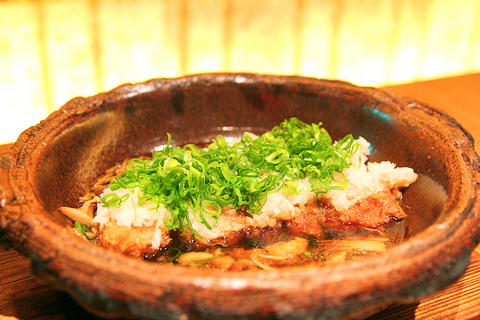Anzu (杏子)
Address: 2, Ln 271, Fuxing S Rd Sec 2, Taipei
(台北市復興南路二段271巷2號)

PHOTO: IAN BARTHOLOMEW, TAIPEI TIMES
Telephone: (02) 2701-0298
Open: Weekdays 1am to 2:30pm, 5pm to 9pm; weekends 11am to 9:30pm
Average meal: NT$400
Details: Chinese menu with pictures; credit cards accepted
Though tonkatsu, or Japanese fried pork cutlet, may seem like simple fare, Anzu, which is hidden in a small alley next to the Technology Building metro station, gives the dish a whole new level of sophistication.
Anzu is well-known in its hometown of Fukuoka, Japan, for making exceptional tonkatsu, and the whole process has been transferred lock, stock and deep-fryer to Taipei. The small, intimate establishment opened its doors this June.
Quality is naturally something that the restaurant emphasizes, and chef Kenny Chen (陳之楷) waxes lyrical about the seven days of aging accorded to each cutlet, and the fine distinctions in texture and taste between tonkatsu made from pork loin or fillet (both are available).
But even before you get into these subtleties, the creative, seasonal menu is likely to grab your attention. The healthy pork fillet pot with a medley of wild mushrooms (綜合野菇里肌豬排善鍋) takes the conventional tonkatsu - a big piece of breaded pork fillet deep-fried until golden and crispy - and tosses it into a light soup of mixed mushrooms, the whole thing topped off with heaps of grated radish and scallions (NT$330). The bottom part of the batter soaks up the soup while the top remains crisp, producing a variety of textures. The mushrooms take tonkatsu to a totally new place on the flavor map. Even the grated radish has a dry crunchiness very different from the usual mush that accompanies so much Japanese food.
This, as with all other dishes on the menu, comes with a bowl of rice (white or mixed grain), a bowl of miso soup (currently either clam with regular miso or wild vegetables with an unusual wheat miso, which is a specialty of Japan's Kyushu island), and a bowl of white sesame seeds that can be ground into the barbecue sauce.
If the large meat portions are too much, another seasonal dish on the menu is deep-fried Canadian oysters with medallions of tenderloin (酥炸鮮牡蠣腰內豬排套餐), which consists of two massive oysters covered in Anzu's crispy breadcrumb mix and two small portions of tonkatsu (NT$350).
Though seafood-eating vegetarians are catered to - Anzu serves a colorful vegetable and shrimp platter (NT$290) - this establishment is primarily designed for carnivores. Portions are substantial by Japanese standards. Sake, shochu (燒酒) and plum wine are available in addition to the usual range of beer, and to finish off, homemade tofu flavored with almonds makes an excellent dessert.

One of the biggest sore spots in Taiwan’s historical friendship with the US came in 1979 when US president Jimmy Carter broke off formal diplomatic relations with Taiwan’s Republic of China (ROC) government so that the US could establish relations with the People’s Republic of China (PRC). Taiwan’s derecognition came purely at China’s insistence, and the US took the deal. Retired American diplomat John Tkacik, who for almost decade surrounding that schism, from 1974 to 1982, worked in embassies in Taipei and Beijing and at the Taiwan Desk in Washington DC, recently argued in the Taipei Times that “President Carter’s derecognition

This year will go down in the history books. Taiwan faces enormous turmoil and uncertainty in the coming months. Which political parties are in a good position to handle big changes? All of the main parties are beset with challenges. Taking stock, this column examined the Taiwan People’s Party (TPP) (“Huang Kuo-chang’s choking the life out of the TPP,” May 28, page 12), the Democratic Progressive Party (DPP) (“Challenges amid choppy waters for the DPP,” June 14, page 12) and the Chinese Nationalist Party (KMT) (“KMT struggles to seize opportunities as ‘interesting times’ loom,” June 20, page 11). Times like these can

June 23 to June 29 After capturing the walled city of Hsinchu on June 22, 1895, the Japanese hoped to quickly push south and seize control of Taiwan’s entire west coast — but their advance was stalled for more than a month. Not only did local Hakka fighters continue to cause them headaches, resistance forces even attempted to retake the city three times. “We had planned to occupy Anping (Tainan) and Takao (Kaohsiung) as soon as possible, but ever since we took Hsinchu, nearby bandits proclaiming to be ‘righteous people’ (義民) have been destroying train tracks and electrical cables, and gathering in villages

Dr. Y. Tony Yang, Associate Dean of Health Policy and Population Science at George Washington University, argued last week in a piece for the Taipei Times about former president Ma Ying-jeou (馬英九) leading a student delegation to the People’s Republic of China (PRC) that, “The real question is not whether Ma’s visit helps or hurts Taiwan — it is why Taiwan lacks a sophisticated, multi-track approach to one of the most complex geopolitical relationships in the world” (“Ma’s Visit, DPP’s Blind Spot,” June 18, page 8). Yang contends that the Democratic Progressive Party (DPP) has a blind spot: “By treating any